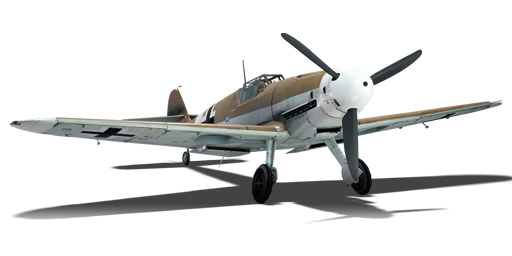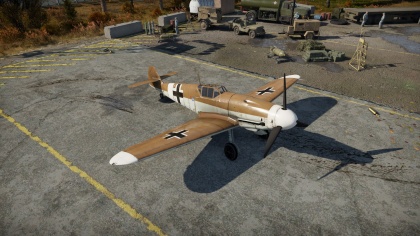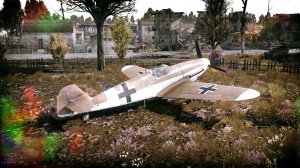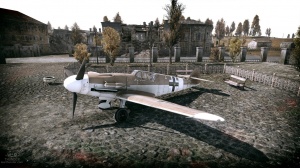Difference between revisions of "Bf 109 G-2/trop"
Inceptor57 (talk | contribs) |
Colok76286 (talk | contribs) (→Media: Reworked structure + removed obsolete links) |
||
| Line 313: | Line 313: | ||
== Media == | == Media == | ||
| − | <!-- | + | <!--Excellent additions to the article would be video guides, screenshots from the game, and photos.--> |
| − | + | ;Skins | |
| − | * [http://live.warthunder.com/feed/camouflages/?q=% | + | * [http://live.warthunder.com/feed/camouflages/?q=%23bf109g2trop Skins for the Bf 109 G-2/trop on WT:Live] |
| − | |||
== See also == | == See also == | ||
Revision as of 12:20, 17 April 2020
Contents
| This page is about the German fighter Bf 109 G-2/trop. For other versions, see Bf 109 (Family). |
Description
The Bf 109 G-2/trop is a rank IV German fighter
with a battle rating of 5.3 (AB) and 4.3 (RB/SB). It has been in the game since the start of the Open Beta Test prior to Update 1.27.
The Bf 109 G-2/trop fulfils many roles in War Thunder: it can be used as a bomber interceptor and as a fighter bomber but where it really shines is the role of a pure fighter. The G-2 should be flown like every Bf 109 in an energy fighting style. The best climbing speed for the G-2 is 230 km/h (IAS) (alternative 270km/h (IAS) to pull of emergency manoeuvres faster) and you should climb from the start with WEP enabled to gain altitude/energy quickly.
This is the /trop (tropical) variant of the "Gustav Zwei". Like the Bf 109 F-4/trop it features an engine intake dust filter, a socket for sun-umbrellas and several other accommodations versus particulate matter. While these modifications allowed for prolonged service life in harsh environments like North Africa, the Russian veld and Libya's desert, they also (marginally) cost top speed and engine performance due to increased air resistance and power diversion for the filtered aspirator.
The Gustav-2, like the Bf 109 F-4, has a very accurate and deadly main armament, which is mainly achieved by the engine mounted MG 151/20 cannon. The MG 151/20 cannon operates at a rate of fire of 750 rounds per minute with a muzzle velocity of 710-785 m/s and is capable to shoot one of the most effective cannon rounds against aircraft: the mighty minengeschoß (eng. Mineshell), which contains 20 g of high explosive filler. The Minengeschoß is in game shown as "HEI - High-explosive incendiary shell (minengeschoß)" and rips wings off with only few hits. It is very likely to hit viable parts of aircraft like fuel tanks and cooling systems because of the fuse delay which allows the Minengeschoß to penetrate half through wings before the shell explodes. The MG 17 machine gun operates at a rate of fire of 1,150 rpm and was used up to the Bf 109 G-4 at which point they finally upgraded with the bigger MG 131 with a calibre of 13 mm. The MG 17 was called "Luftwaffenanklopfgerät" (eng. Airforce-knock-knock-thing) derogatorily by German Luftwaffe pilots due to the small calibre and damage effect on aircraft.
General info
Flight performance
Describe how the aircraft behaves in the air. Speed, manoeuvrability, acceleration and allowable loads - these are the most important characteristics of the vehicle.
| Characteristics | |||||||
|---|---|---|---|---|---|---|---|
| Stock | |||||||
| Max Speed (km/h at 6,500 m) |
Max altitude (meters) |
Turn time (seconds) |
Rate of climb (meters/second) |
Take-off run (meters) | |||
| AB | RB | AB | RB | AB | RB | ||
| 659 | 643 | 13200 | 20.0 | 20.7 | 19.6 | 19.6 | 304 |
| Upgraded | |||||||
| Max Speed (km/h at 6,500 m) |
Max altitude (meters) |
Turn time (seconds) |
Rate of climb (meters/second) |
Take-off run (meters) | |||
| AB | RB | AB | RB | AB | RB | ||
| 705 | 682 | 13200 | 18.0 | 19.0 | 27.6 | 23.2 | 304 |
Details
| Features | ||||
|---|---|---|---|---|
| Combat flaps | Take-off flaps | Landing flaps | Air brakes | Arrestor gear |
| ✓ | ✓ | ✓ | X | X |
| Limits | ||||
|---|---|---|---|---|
| Wing-break speed (km/h) |
Gear limit (km/h) |
Combat flaps (km/h) |
Max Static G | |
| + | - | |||
| 460 | ~12 | ~6 | ||
| Optimal velocities | |||
|---|---|---|---|
| Ailerons (km/h) |
Rudder (km/h) |
Elevators (km/h) |
Radiator (km/h) |
| < 450 | < 390 | < 450 | > 715 |
| Compressor (RB/SB) | ||
|---|---|---|
| Setting 1 | ||
| Optimal altitude | 100% Engine power | WEP Engine power |
| 5,700 m | 1,260 hp | 1,399 hp |
Survivability and armour
- 60 mm Bulletproof glass in front of the pilot.
- 4-8 mm Steel plates on pilot seat.
- 10 mm Steel plates around the pilot's head.
- 21 mm Steel plate on the rear of the fuel tank, with 4 mm plates surrounding it on other sides.
Armaments
Offensive armament
The Bf 109 G-2/trop is armed with:
- 1 x 20 mm MG 151/20 cannon, nose-mounted (200 rpg)
- 2 x 7.92 mm MG 17 machine guns, nose-mounted (500 rpg = 1,000 total)
The two machine guns are in the upper part of the fuselage just in front of the cockpit. The 20 mm cannon is mounted to fire through the propeller shaft and out the propeller hub.
Recommended Ammunition Belts
Pilots who are really experienced with the aiming and hitting of the MG 151/20, might want to use stealth belts on the MGs and cannons, to avoid being spotted by tracers. Using stealth belts on the machine guns only is also useful for aiming the cannon more easily without the distraction provided by the light machine gun tracers.
- MG 151/20
- Air Targets: Air Targets (AP-I/HEI/HEI/HEI/HEI/IT) // Consisting of 2/3 Minengeschoße, this belt is very effective against any aircraft.
- Ground Targets: Armored Targets (APHE/APHE/APHE/IT)
- MG 17
- Air Targets: Universal (AP-T/AP/AI/AP-I)
- Ground Targets: Tracer (AP-T)
Suspended armament
The Bf 109 G-2/trop can be outfitted with the following ordnance:
- Without load
- 4 x 50 kg SC50JA bombs (200 kg total)
- 1 x 250 kg SC250JA bomb (250 kg total)
- 2 x 20 mm MG 151/20 cannons, gunpods (wing-mounted) (135 rpg = 270 total)
Usage in battles
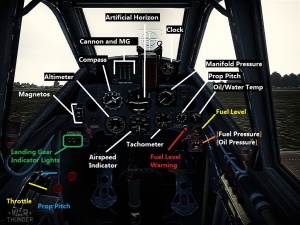
Fighter:
The Bf 109 G-2 was designed as a fighter aircraft and thus excels in the role of it. It reaches its maximal performance with of course no secondary weapons equipped. However, if one 20 mm MG 151/20 is not sufficient, especially against bombers, utilising two extra MG 151/20 in form of gunpods will noticeably increase firepower at the expense of a slight loss in flight performance.
Bomber interceptor:
When facing any bombers (e.g. B-25, B-17, Wellington, Yer-2) one should never simply stay behind them and spray the guns all over the bomber. To take out any bomber effectively, the best tactic is to come in with high speed out of a steep angle and focus the guns on just one wing. This will give the bombers' gunners a harder time to ward off the attacker, whilst focusing on only one wing increases greatly the chance of a critical hit, either snapping off a wing or making the bomber uncontrollable. Since it can be quite hard to snap off a wing of a bomber with "only" one MG 151/20, it is highly recommended to make use of the previously mentioned 20 mm MG 151/20 gunpods.
Fighter Bomber:
The G-2 can also be used as a fighter bomber. To fulfil this role one has the choice between either one 250 kg bomb or four 50 kg bombs, which are dropped in pairs of two. The 250 kg bomb is quite easily capable of destroying hard ground targets like pillboxes and tanks, while the 50 kg bombs can only crack such targets with a direct hit/detonation on target. Please note that only on rare occasions it is helpful to waste the G-2s fighter capabilities with ground attacking in order to achieve victory in a mission.
Arcade Battles: The G-2 in AB has a massively elevated performance. Climb rate is insane due to the lack of engine damage from overheating and performance losses from the 2 gunpods are almost nonexistent or unnoticeable. The aforementioned gun pods greatly improve the damage output, important for the fast past action in Arcade. Although in a true one versus one against more agile opponents such as Spitfire Mk.V, one would wish to not have equipped the pods for better agility.
Flying the G-2 in a strict Boom and Zoom style is recommended for beginners in Arcade.
Realistic Battles/Simulator Battles: During a dive, redlining starts at 750 km/h (IAS) and your aircraft breaks apart around 820 km/h (IAS) and til you reach this speed you can not rip your wings off with pulling up. You have access to 20/30/45 minutes of fuel, for most maps 30 minutes of fuel is a good choice.
While in the offence against a fighter in the Bf 109 G-2/trop (i.e. with an energy advantage, ready to engage the enemy either by diving or zoom climbing), a swift pass landing 20 mm hits in the wing should suffice to take down the opponent. If the opponent avoids the attack by applying defensive manoeuvres, the energy the evading opponent lost in the process will put the attacking Bf 109 in an even larger advantage, so 'Gustav' pilots should face this situation as an advantage and handle it patiently, not wasting ammunition nor risking lengthy and risky horizontal turn fighting. The pilot should gain altitude (bear in mind that, without a comfortable distance from enemies, climbing can equate to giving an optimal shot to the enemy), get enough room to position for another strike and finally re-engage the enemy fighter, hopefully striking it down. All these precautions are of course much less necessary when no threats are nearby. In this case, aggressive dog fighting while still relying on the energy advantage can be the quickest way to take any opponent down. At speeds around 350-450 km/h (IAS) the horizontal turning ability of the G-2 is at its finest and can be further improved with the use of combat/take off flaps. The key is situational awareness to realize such opportunities.
As for situations when the Gustav-2 pilot is in the defence (i.e. with an energy disadvantage, prone to being fatally engaged by an enemy either by diving or zoom climbing), either due to not climbing optimally or by facing tough opponents such as the Spitfire LF. Mk IX (known for its climb rate), (s)he will likely risk head-on engagements. Head-ons are generally a bad idea because you risk your own machine to take damage. But with the armament of the G-2 which is very accurate and deadly (especially with gunpods), you have good chances to kill or at least damage an enemy at distances of 1.0 - 1.2 km just by firing a burst and then evade the head on with for example a simple downwards barrel roll without taking a single hit. This needs, of course, some experience to hit at these long ranges. Example Video
If the enemy owns the energy advantage, your best bet is to avoid his attacks with simple and energy efficient manoeuvres like the Split-S and climb every time you have the time to. But keep in mind: Slow targets are much easier to hit than fast targets, so convert your altitude early enough to speed to avoid an incoming attack successfully. Another option can be to evade an enemy Boom and Zoom attack with a simple downwards barrel roll, when the enemy overshoots you and starts climbing again you have a small time window to fire a burst at him.
Useful air combat manoeuvres
- Hammerhead
- Rope-A-Dope
- High / low Yo-yo
- Rolling Scissors
- Split S
- Manual engine control
- Advanced energy fighting
- Boom & Zoom
Specific enemies worth noting
There are a variety of deadly opponents the Bf 109 G-2/trop may face, and one should be very careful when battling such aircraft.
✭ Soviet Aircraft:
Against Soviet aircraft, one should be careful and climb high at the start of the match, since the majority of Soviet fighters at the G-2's level outperform it in practically every aspect at low altitude, whilst losing lots of performance at medium and high altitudes. The performance of aircraft like the La-5FN or the Yak-3 starts to drop at 3,000 m, whilst the Bf 109 G-2 will do perfectly well at altitudes like 6,000m. Climbing to a high altitude is key to success. At these altitudes, the G-2 pilot can Boom & Zoom Soviet fighters as well as turnfight them, the only major concern is not to lose the hard-earned altitude and become a low and slow target. One very exploitable disadvantage of Soviet aircraft is their proneness to crashing at high speeds. Either offensively or defensively, the Bf 109 G-2/trop can dive faster than all of its Soviet opponents, since it will not crash from over-speed at any less than 800 km/h (IAS), whilst most Soviet fighters struggle to reach 720 km/h (IAS). If in disadvantage at low altitude and the situation does not allow to dive away, G-2 pilots should try to lead their six towards teammates and/or friendly AAA.
✪ USAF Aircraft:
Fighting against American aircraft is a very interesting experience. First, fighters like the F4U-1c Corsair, the P-51D-5 Mustang and the P-47D-25 Thunderbolt are better divers by far than the Bf 109 G-2, reaching higher speeds, manoeuvring better at high speed, and also much more efficient in high-speed climbs, excelling at the fighting style known as Boom & Zoom. Therefore, the G-2 pilot must exploit other advantages of the plane, namely its good horizontal manoeuvrability at speeds from 350 km/h to 450 km/h (IAS) and its impressive rate of climb and acceleration thanks to a very favourable power-to-weight ratio. Meanwhile, the majority of American fighters are heavy and can neither turn well nor climb well (in a sustained climb). The priority against American fighters should be to gain an energy advantage. If these are fast, then trying to beat them in a climb is not really an option, so engaging in tight, speed-costly manoeuvres is the best choice, in order to leave the enemy at a speed where they can be out-climbed. At this point, the Bf 109 pilot can either climb to gain an advantage or continue manoeuvring aggressively in order to get the guns on the target and shoot it down. In situations of numerical inferiority, patience is important - climbing to gain an advantage is more advisable than obsessing with getting an immediate kill. There are of course some American aircraft against which the Gustav pilot will have no particular advantage in regards to climb rate and acceleration, such as the Kingcobra or the XP-50. If the pilot has no energy advantage on these aircraft, lining up for a shot is a difficult task.
♔ British Aircraft:
As for British planes, the Spitfires will out-turn the Bf-109 G-2/trop horizontally with ease. Never forget to climb, it is often the 109s only constant advantage. The biggest British threat found on a regular base is the Typhoon Mk Ib. This fighter mounts 4 x 20 mm cannons whilst having a decent climb rate, very good dive capabilities and sufficient turn rates. The best bet to counter this aircraft is in manoeuvres which rely on the roll rate of a plane (e.g. rolling scissors), simply because the Typhoon's roll rate is appalling. An even bigger threat but thankfully only fighting the G-2 rarely is the Spitfire LF Mk IX. This fighter outperforms the G-2 in almost every aspect and should be always number one priority to take down.
❁ Japanese Aircraft:
Japanese A6M and Ki-43 fighters turn horizontally even better than the Spitfires and are overall very manoeuvrable. Never engage these fighters in a dog fight. Rely on the 109s superior speed and high altitude performance instead. A big threat for the G-2 are the J2M3 and Ki-84 fighters, both climb and accelerate very good. However the J2M3 performs poor at high speeds (compression) unlike the Ki-84 which is a great diver. But you can beat both in a horizontally turn fight.
✙ German Aircraft:
The German Fw 190 is an excellent diver with also excellent maximum speeds and roll rates, but an awful horizontal turner and an average climber compared to the Bf 109 G-2. Engaging the Fw 190 horizontally is often the easiest way to win a dog fight. If you meet another Bf 109 focus it and avoid losing the energy advantage.
Manual Engine Control
| MEC elements | ||||||
|---|---|---|---|---|---|---|
| Mixer | Pitch | Radiator | Supercharger | Turbocharger | ||
| Oil | Water | Type | ||||
| Not controllable | Controllable Auto control available |
Controllable Auto control available |
Controllable Auto control available |
Separate | Not controllable 1 gear |
Not controllable |
Modules
| Tier | Flight performance | Survivability | Weaponry | ||
|---|---|---|---|---|---|
| I | Fuselage repair | Radiator | Offensive 7 mm | ETC 50/VIIId | |
| II | Compressor | Airframe | New 7 mm MGs | ||
| III | Wings repair | Engine | Offensive 20 mm | ETC 500/IXb I | |
| IV | Engine injection | Cover | New 20 mm cannons | R6 modification | |
- It is recommended to unlock all flight performance and survivability modules first, with exception of the weaponry module "Offensive 20 mm". Unlock this upgrade as soon as you can, because it gains access to the "Air Targets" ammo belt, which provides significantly larger damage effects than the default belt.
Pros and cons
Pros:
- Excellent rate of climb
- Very effective armament
- Strongest thrust/mass ratio of all Bf 109s in War Thunder
- Good acceleration and roll rate
- Not easy to rip your wings off (important for RB & SB)
- High agility at moderate speeds (350-450 km/h)
- Fulfils many roles in War Thunder
Cons:
- Inferior horizontal turn rate compared to most opponents at low speeds
- High manoeuvrability often lures inexperienced users of this aircraft to engage in turn fights
- Bad high speed performance (locks up early)
- Bad cockpit visibility (important for SB)
- Only able to trim elevator (important for SB)
- Can not handle damage like every small aircraft
- Can be ineffective when stock
History
The Bf 109 is a single-seat monoplane fighter which was the back bone of the German airforce; before and during WWII. It was designed, by Wilhelm Emil Messerschmitt; in the year 1934 and was continuously improved until 1945. The German Luftwaffe used in such roles as: a fighter; interceptor; high-altitude interceptor; fighter-bomber and reconnaissance aircraft. It is also, one of the most produced fighter aircraft; with around 34,000 built from 1936 to April 1945.
The production of the Bf 109 Gustav-2 started in spring 1942 and was the first Bf 109 to arrive combat units with the new DB 605 A engine. The suffix /trop means that this 109 has a special filter mounted to prevent damaging the engine from sand and other particles, which allowed combat use in tropical areas like deserts. The German Luftwaffe used this version in Africa. The famous German fighter ace Hans-Joachim Marseille died due to a technical defect in his Bf 109 G-2/trop "Yellow 14".
In-game description
The Messerschmitt Bf 109 was a single-seat monoplane fighter used by the Luftwaffe before and during WWII. It was used as a fighter, interceptor, high-altitude interceptor, fighter-bomber and reconnaissance aircraft.
The Bf 109 G "Gustav" was the most mass-produced variant of the 109, powered by the Daimler-Benz DB 605. The 605 was basically a DB 601 with the cylinder block redesigned to increase displacement from 33.9, to 35.7 liters - which resulted in 175 extra HP with no significant change in size. The Gustav also received improved armament. Instead of the previously standard 7.62mm MG 17 machine guns, 13mm MG 131 heavy machine guns were used. The heavier guns lead to distinct cowling bulges, needed to cover the breechblocks on the new guns.
However, the increased equipment led to heavier weight on the Gustav, in fact 10% heavier than the Friedrich. Compared to the much earlier Bf 109B, the Gustav was almost 46% heavier. The new aircraft had begun to reach front-line units by May 1942. In essence, the Bf 109 design had reached its peak, and would ideally need to be replaced with newer, more modern designs. However, the troubled Me 209 replacement was still in development and things at the front were beginning to look ominous for Germany. Consequently, the RLM decided to continue to further refine the 109.
Media
- Skins
See also
- Aircraft of comparable role, configuration and era
- Mitsubishi A6M
- Bell P-39 Airacobra
- Curtiss P-36
- Curtiss P-40
- Dewoitine D.520
- Fiat G.55
- Focke-Wulf Fw 190
- Grumman F4F Wildcat
- Grumman F6F Hellcat
- Hawker Hurricane
- Heinkel He 112
- IAR-81
- Kawasaki Ki-61
- Lavochkin LaGG-3
- Macchi C.202
- Macchi C.205
- Mikoyan-Gurevich MiG-3
- Morane-Saulnier MS.406
- Nakajima Ki-43
- North American P-51 Mustang
- Polikarpov I-16
- Supermarine Spitfire
- Yakovlev Yak-1
- Yakovlev Yak-9
External links
German:
- Falcon's Messerschmitt Bf 109 Hangar: 109G-2
- Falcon's Messerschmitt Bf 109 Hangar: 109G-2/trop
- Wikipedia.de "Bf 109 G" section
- Wikipedia.de German Minenmunition
English:
- Wikipedia.en "Bf 109 G" section
- Wikipedia.en "Hans-Joachim Marseille - Death" section
- Flight data - google docs spreadsheet
- War Thunder Flight model data sheet for the 109G-2 (non tropical variant!)
- www.wwiiaircraftperformance.org: Me 109G2/trop
| Germany fighters | |
|---|---|
| Heinkel | |
| He 51 | He 51 A-1 · He 51 B-1 · He 51 B-2/H · He 51 C-1 · He 51 C-1/L |
| He 100 | He 100 D-1 |
| He 112 | He 112 A-0 · He 112 B-0 · He 112 B-1/U2 · He 112 B-2/U2 · He 112 V-5 |
| Messerschmitt | |
| Bf 109 (Jumo) | Flegel's Bf 109 A · Bf 109 B-1 · Bf 109 C-1 · Bf 109 C-1 |
| Bf 109 (DB-601) | Bf 109 E-1 · Bf 109 E-3 · Bf 109 E-4 · Bf 109 E-7/U2 · Bf 109 F-1 · Bf 109 F-2 · Bf 109 F-4 · Bf 109 F-4/trop |
| Bf 109 (DB-605) | Bf 109 G-2/trop · Bf 109 G-2 · Bf 109 G-6 · Bf 109 G-10 · Bf 109 G-14 · Bf 109 K-4 |
| Focke-Wulf | |
| Fw 190 (early) | Fw 190 A-1 · Fw 190 A-4 · Fw 190 A-5 · Fw 190 A-5 · Fw 190 A-5/U2 · Fw 190 A-5/U14 · Fw 190 A-8 · Fw 190 C |
| Fw 190 (late) | Fw 190 D-9 · Fw 190 D-12 · Fw 190 D-13 |
| Ta 152 | Ta 152 C-3 · Ta 152 H-1 |
| Blohm & Voss | |
| BV 155 | BV 155 B-1 |
| Captured: | |
| USA | ▀P-47D-16-RE · ▀P-47D |
| USSR | ▀La-5FN · ▀Yak-1B |
| Britain | ▀Tempest Mk V |
| Italy | |
| CR.42 | ▀CR.42 · ▀Marcolin's C.R.42 CN |
| G.50 | ▀G.50 serie 2 · ▀G.50 AS serie 7 |
| C.200 | ▀C. 200 serie 3 · ▀C. 200 serie 7 |
| C.202 | ▀C. 202 |
| Finland | ▀Hawk H-75A-2 |


